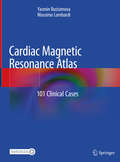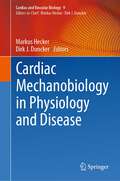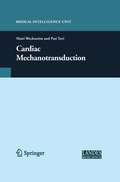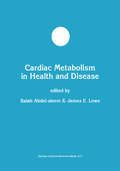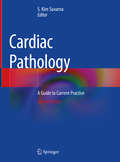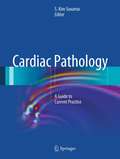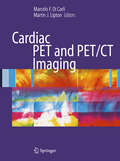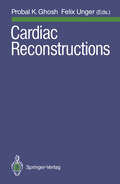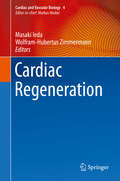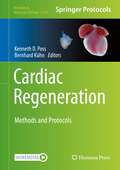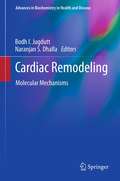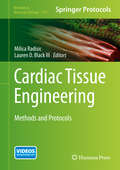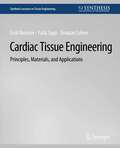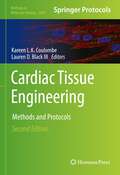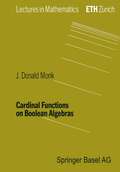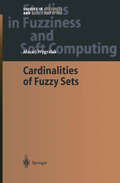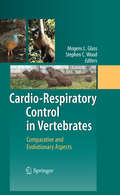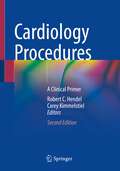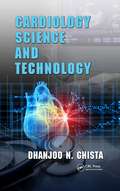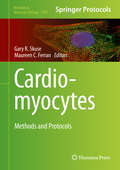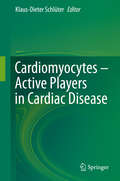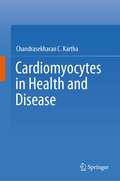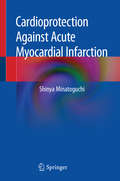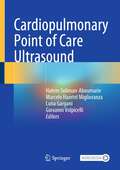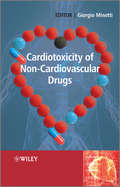- Table View
- List View
Cardiac Magnetic Resonance Atlas: 101 Clinical Cases
by Yasmin Rustamova Massimo LombardiThis book presents the main cardiac pathologies, providing a helpful guide featuring clinical cases and electronic supplementary material. There are several systematic books on cardiac magnetic resonance, which approach the different pathologies and related pathophysiology in a general manner, and these are useful for readers at an early stage in their medical careers. However, when it comes to individual patients (during the acquisition of images and reporting activities) there is no book providing operative protocols or systematic descriptions of details to look for. In the eight chapters (Cardiomyopathies, Myocarditis, Ischemic Heart Disease, Valvular Heart Diseases, Cardiac Masses, Pericardial Diseases, Congenital Heart Disease, and Miscellanea), the individual pathology is illustrated with a clinical case.The cases are divided into four sections: An introduction with a short medical history and the purpose of the diagnostic CMRA detailed CMR acquisition protocolCMR images, indicating purpose, method, analysis and meaning of the image, as well as videos.Concluding paragraph with the final diagnosis reached on the basis of the findings obtained in each image This book, collecting one hundred one clinical cases covering a broad spectrum of cardiac diseases, is an invaluable tool for radiologists and cardiologists.
Cardiac Mechanobiology in Physiology and Disease (Cardiac and Vascular Biology #9)
by Markus Hecker Dirk J. DunckerThis book presents the latest findings in the field of cardiac mechanobiology in health and disease.Cardiac mechanobiology provides knowledge of all aspects of mechanobiology of the heart. Cardiomyogenesis is discussed as well as the mechanobiology of cardiac remodeling and regeneration. The molecular mechanisms of mechanoperception and mechanotransduction in cardiomyocytes are explained, as well as stretch induced differentiation of cardiomyocytes derived from induced pluripotent stem cells. This volume of the series Cardiac and Vascular Biology complements the volume Vascular Mechanobiology in Physiology and Disease (volume 8) published in this series. The book is aimed at clinicians as well as researchers in cardiovascular biology, bioengineering and biophysics, and also represents an educational resource for young researchers and students in these fields.
Cardiac Mechanotransduction
by Matti Weckström Pasi TaviThis book presents a multidisciplinary approach to cardiac mechanotransduction. The chapters depict the many faces of the topic, from membrane and ion channel level to mechanics, biochemical signaling and regulation via hormone systems. Cardiac Mechanotransduction is of interest to basic life sciences, like physiology, biochemistry and pharmacology, but also to clinicians working with heart-related problems, such as cardiologists and internists.
Cardiac Metabolism in Health and Disease (Developments in Molecular and Cellular Biochemistry #23)
by James E. Lowe SalahAbdel-AleemThis special issue of Molecular and Cellular Biochemistry contains original research papers as well as invited reviews focused in the field of cardiac metabolism and its regulation under normal and disease conditions. These papers cover many areas under intensive and rapid development such as the regulation of fatty acid oxidation in the heart, the role of cardiac glycogen during ischemia, the role of CPT I isoenzymes, the pathophysiology of diabetic cardiomyopathy, cardiac protection through regulation of energy production, the role of fatty acid binding protein under normal and pathological conditions, and several other important topics in this area of research. We hope that this special issue of Molecular and Cellular Biochemistry provides an up-to-date source of information for scientists and clinicians interested in the mechanism by which cardiac metabolism is regulated in health and disease and the mechanistic relationship between disturbances in cardiac metabolism and the genesis of cardiovascular diseases.
Cardiac Pathology: A Guide to Current Practice
by S. Kim SuvarnaThis updated second edition provides a comprehensive overview of cardiac pathology. Clear illustrations of the common styles of dissection are provided along with the normal anatomy and histology. The chapters cover autopsy heart examination, ischemic heart disease, myocarditis, sudden death, valvular disease, transplant pathology, cardiomyopathy, cardiac neoplasia and congenital heart disease with a clear analysis of diagnostic criteria (macroscopic, microscopic and genetic) for both common cardiac diseases and those of less common types. The text is accompanied by high quality macroscopic and microscopic images and references to other specialty data sources. Cardiac Pathology: A Guide to Current Practice is aimed at established pathologists and trainees, as well as any clinician with an interest in cardiac disease. It will be of value to those working in cardiac surgery, cardiology and those in the autopsy/forensic fields.
Cardiac Pathology: A Guide to Current Practice
by S. Kim SuvarnaCardiac disorders are an exciting area of classic pathology and recently defined disease. Cardiac Pathology: A Guide to Current Practice discusses the various disorders and also provides a backdrop of developmental embryology, diagnostic imaging and current therapeutics. Cardiac Pathology: A Guide to Current Practice aims to deliver in bench-book format a comprehensive overview of cardiac pathology that is relevant to those practicing in surgical pathology and autopsy arenas. Clear illustrations of the common styles of dissection are provided along with the normal anatomy and histology. Chapters cover the approach to the autopsy heart, ischemic heart disease, myocarditis, sudden death, valvular disease, transplant pathology, cardiomyopathy, cardiac neoplasia and congenital heart disease with a clear analysis of diagnostic criteria (macroscopic, microscopic and genetic) for both common cardiac diseases and those of rare format. The text is accompanied by high-quality macroscopic and microscopic images and references to other in-depth specialty data sources. Although aimed in particular at pathologists, Cardiac Pathology: A Guide to Current Practice should also be of value to cardiologists, cardiothoracic surgeons and other professions allied to medicine.
Cardiac PET and PET/CT Imaging
by Marcello F. Di Carli Martin J. LiptonThis book presents the most up-to-date information on the practice of cardiac PET and hybrid PET/CT. Each chapter takes a step-by-step approach, from basic principles of instrumentation, imaging, and protocols to advanced discussions of current and future clinical applications. Coverage also includes a perspective on other emerging imaging modalities, such as MRI, and the relative role of each. In addition, the volume details the technical aspects of cardiac PET and PET/CT imaging. A library of original cases completes the text by illustrating interpretation and technical challenges in cardiac PET and hybrid PET/CT.
Cardiac Reconstructions
by Probal K. Ghosh Felix UngerAttempts to reconstruct various parts of the heart started even before the beginning of open cardiac surgery. By the late 1950s and early 1960 s several closed and open procedures had already been described. In that era, several surgeons in Europe and the Americas were particularly prompted to develop various techniques of valve re construction because of the lack of acceptable valve prostheses and conduits which have become available subsequently. At that time, several congenital lesions still defied definitive correction, and clinical attempts at left ventricular wall replacement had not yet got under way. A renaissance in different cardiac reconstructive procedures started at the beginning of the 1980s. As the problems relating to valve prostheses became more generally appreciated and the importance of chamber volumes and geometry (atrial or ventricular) was accorded due importance in the long-term follow-up, there was a resurgence of surgical attempts at reconstruction in congenital and acquired cardiac lesions so as to approximate the natural state. At the same time several characteristics of this reconstructive "discipline" became apparent. First, cardiac reconstructive surgery has remained a surgical "art" with a gradually increasing number of interested cardiac surgeons.
Cardiac Regeneration (Cardiac and Vascular Biology)
by Masaki Ieda Wolfram-Hubertus ZimmermannThis Volume of the series Cardiac and Vascular Biology offers a comprehensive and exciting, state-of-the-art work on the current options and potentials of cardiac regeneration and repair.Several techniques and approaches have been developed for heart failure repair: direct injection of cells, programming of scar tissue into functional myocardium, and tissue-engineered heart muscle support. The book introduces the rationale for these different approaches in cell-based heart regeneration and discusses the most important considerations for clinical translation. Expert authors discuss when, why, and how heart muscle can be salvaged.The book represents a valuable resource for stem cell researchers, cardiologists, bioengineers, and biomedical scientists studying cardiac function and regeneration.
Cardiac Regeneration: Methods and Protocols (Methods in Molecular Biology #2158)
by Kenneth D. Poss Bernhard KühnThis detailed book addresses major goals of regenerative medicine and the cardiovascular research community with techniques to replenish lost cardiomyocytes, avoid scar-associated pathology, and improve myocardial infarction (MI) outcomes. The collection begins with a section on cardiac injury models, including zebrafish, neonatal and adult mice, and pigs, and continues with sections covering culturing cardiomyocytes from different species as well as methods for labeling or manipulation of cardiac tissue for the purpose of answering questions in regeneration. Written for the highly successful Methods in Molecular Biology series, chapters include introductions to their respective topics, lists of the necessary materials and reagents, step-by-step, readily reproducible laboratory protocols, and tips on troubleshooting and avoiding known pitfalls. Authoritative and practical, Cardiac Regeneration: Methods and Protocols provides the latest models and methods used in the field of heart regeneration, designed for researchers interested in establishing these assays in their laboratories to reproduce or extend findings, and for familiarizing themselves with the field if it is new to them.
Cardiac Remodeling: Molecular Mechanisms (Advances in Biochemistry in Health and Disease)
by Bodh I. Jugdutt and Naranjan S. DhallaThe main objective of Cardiac Remodeling: Molecular Mechanisms is to summarize the major research advances in molecular, biochemical and translational aspects of cardiac remodeling over the last 2 to 3 decades under one cover and touch on future directions. It provides a high profile and valuable publication resource on molecular mechanisms of cardiac remodeling for both the present and future generations of researchers, teachers, students and trainees. This book should stimulate future translational research targeted towards discovery and development for preventing, limiting and reversing bad remodeling over the next few decades, with the ultimate goal of preventing progression to systolic and/or diastolic heart failure. The chapters suggest potential novel strategies that should receive attention for translating basic research knowledge to application in patients at the bedside.
Cardiac Tissue Engineering: Methods and Protocols (Methods in Molecular Biology #1181)
by Milica Radisic And Lauren D. Black IIICardiac Tissue Engineering: Methods and Protocols presents a collection of protocols on cardiac tissue engineering from pioneering and leading researchers around the globe. These include methods and protocols for cell preparation, biomaterial preparation, cell seeding, and cultivation in various systems. Written in the highly successful Methods in Molecular Biology series format, chapters include introductions to their respective topics, lists of the necessary materials and reagents, step-by-step, readily reproducible laboratory protocols, and key tips on troubleshooting and avoiding known pitfalls.Authoritative and practical, Cardiac Tissue Engineering: Methods and Protocols highlights the major techniques, both experimental and computational, for the study of cardiovascular tissue engineering.
Cardiac Tissue Engineering (Synthesis Lectures on Tissue Engineering)
by Smadar Cohen Emil Ruvinov Yulia SapirCardiac tissue engineering aims at repairing damaged heart muscle and producing human cardiac tissues for application in drug toxicity studies. This book offers a comprehensive overview of the cardiac tissue engineering strategies, including presenting and discussing the various concepts in use, research directions and applications. Essential basic information on the major components in cardiac tissue engineering, namely cell sources and biomaterials, is firstly presented to the readers, followed by a detailed description of their implementation in different strategies, broadly divided to cellular and acellular ones. In cellular approaches, the biomaterials are used to increase cell retention after implantation or as scaffolds when bioengineering the cardiac patch, in vitro. In acellular approaches, the biomaterials are used as ECM replacement for damaged cardiac ECM after MI, or, in combination with growth factors, the biomaterials assume an additional function as a depot for prolonged factor activity for the effective recruitment of repairing cells. The book also presents technological innovations aimed to improve the quality of the cardiac patches, such as bioreactor applications, stimulation patterns and prevascularization. This book could be of interest not only from an educational perspective (i.e. for graduate students), but also for researchers and medical professionals, to offer them fresh views on novel and powerful treatment strategies. We hope that the reader will find a broad spectrum of ideas and possibilities described in this book both interesting and convincing. Table of Contents: Introduction / The Heart: Structure, Cardiovascular Diseases, and Regeneration / Cell Sources for Cardiac Tissue Engineering / Biomaterials: Polymers, Scaffolds, and Basic Design Criteria / Biomaterials as Vehicles for Stem Cell Delivery and Retention in the Infarct / Bioengineering of Cardiac Patches, In Vitro / Perfusion Bioreactors and Stimulation Patterns in Cardiac Tissue Engineering / Vascularization of Cardiac Patches / Acellular Biomaterials for Cardiac Repair / Biomaterial-based Controlled Delivery of Bioactive Molecules for Myocardial Regeneration
Cardiac Tissue Engineering: Methods and Protocols (Methods in Molecular Biology #2485)
by Kareen L. K. Coulombe Lauren D. Black IIIThis detailed volume presents an updated collection of state-of-the-art protocols in cardiac tissue engineering. These protocols demonstrate advancements in cell sourcing, assembly, and use of engineered cardiac tissues, imaging and diagnostics, as well as therapeutic applications. New animal models, biomaterials, and quantitative analyses are described for broad adoption. Written for the highly successful Methods in Molecular Biology series, chapters include introductions to their respective topics, lists of the necessary materials and reagents, step-by-step, readily reproducible laboratory protocols, and tips on troubleshooting and avoiding known pitfalls. Authoritative and practical, Cardiac Tissue Engineering: Methods and Protocols, Second Edition serves as an ideal resource for inspiring the advancement of cardiotoxicity assessment, drug discovery, and heart repair and regeneration in order to accelerate heart health improvement around the globe.
Cardinalities of Fuzzy Sets (Studies in Fuzziness and Soft Computing #118)
by Maciej WygralakCounting is one of the basic elementary mathematical activities. It comes with two complementary aspects: to determine the number of elements of a set - and to create an ordering between the objects of counting just by counting them over. For finite sets of objects these two aspects are realized by the same type of num bers: the natural numbers. That these complementary aspects of the counting pro cess may need different kinds of numbers becomes apparent if one extends the process of counting to infinite sets. As general tools to determine numbers of elements the cardinals have been created in set theory, and set theorists have in parallel created the ordinals to count over any set of objects. For both types of numbers it is not only counting they are used for, it is also the strongly related process of calculation - especially addition and, derived from it, multiplication and even exponentiation - which is based upon these numbers. For fuzzy sets the idea of counting, in both aspects, looses its naive foundation: because it is to a large extent founded upon of the idea that there is a clear distinc tion between those objects which have to be counted - and those ones which have to be neglected for the particular counting process.
Cardio-Respiratory Control in Vertebrates: Comparative and Evolutionary Aspects
by Mogens L. Glass Stephen C. WoodHopefully, this book will be taken off of the shelf frequently to be studied carefully over many years. More than 40 researchers were involved in this project, which examines respiration, circulation, and metabolism from ?sh to the land vertebrates, including human beings. A breathable and stable atmosphere ?rst appeared about 500 million years ago. Oxygen levels are not stable in aquatic environments and exclusively water-breathing ?sh must still cope with the ever-changing levels of O 2 and with large temperature changes. This is re?ected in their sophisticated count- current systems, with high O extraction and internal and external O receptors. 2 2 The conquest for the terrestrial environment took place in the late Devonian period (355–359 million years ago), and recent discoveries portray the gradual transitional evolution of land vertebrates. The oxygen-rich and relatively stable atmospheric conditionsimpliedthatoxygen-sensingmechanismswererelativelysimpleandl- gain compared with acid–base regulation. Recently, physiology has expanded into related ?elds such as biochemistry, molecular biology, morphology and anatomy. In the light of the work in these ?elds, the introduction of DNA-based cladograms, which can be used to evaluate the likelihood of land vertebrates and lung?sh as a sister group, could explain why their cardio-respiratory control systems are similar. The diffusing capacity of a duck lung is 40 times higher than that of a toad or lung?sh. Certainly, some animals have evolved to rich high-performance levels.
Cardiology Procedures: A Clinical Primer
by Robert C. Hendel Carey KimmelstielThis extensively revised edition is a single compact reference that describes a wide variety of diagnostic and therapeutic procedures performed by cardiologists. The focus is on the clinical application of these procedures with descriptions of their technical aspects, as well as contraindications and potential complications. The book provides detailed instruction on the interpretation of clinical data generated during these procedures and includes case presentations to illustrate how they are utilized in clinical practice.Cardiology Procedures: A Clinical Primer contains distilled clinical information and data important to those involved in the clinical care of cardiac patients. Comprising practical material designed to help in learning the diagnostic and therapeutic cardiology procedures performed in clinical practice, it will also be useful for trainees and practitioners in related disciplines.
Cardiology Science and Technology
by Dhanjoo N. GhistaCardiology Science and Technology comprehensively deals with the science and biomedical engineering formulations of cardiology. As a textbook, it addresses the teaching, research, and clinical aspects of cardiovascular medical engineering and computational cardiology. The books consists of two sections. The first section deals with left ventricular
Cardiomyocytes: Methods and Protocols (Methods in Molecular Biology #1299)
by Gary R. Skuse and Maureen C. FerranThis volume has been assembled for scientists interested in basic and applied biomedical research directed toward understanding the development, genetics and function of cardiomyocytes. The methods and protocols contained within it address cell culture techniques, cardiomyocyte differentiation and redifferentiation, experimental induction of cardiomyopathies, introducing genes into cardiomyocytes, genomic approaches to the understanding cardiomyocytes, cryopreservation of neonatal cardiomyocytes and modeling of cardiomyocyte function. Written in the highly successful Methods in Molecular Biology series format, chapters include introductions to their respective topics, lists of the necessary materials and reagents, step-by-step, readily reproducible laboratory protocols and tips on troubleshooting and avoiding known pitfalls. Practical and current, Cardiomyocytes: Methods and Protocols explores complimentary areas of cardiomyocyte science that, taken together, can inform individuals with a broad range of interests.
Cardiomyocytes – Active Players in Cardiac Disease
by Klaus-Dieter SchlüterThis book summarizes our current understanding about the biology and patho-biology of cardiomyocytes and depicts common techniques for the study of these cells. The book is divided into two parts; the first part provides insight into role and function of cardiomyocytes under normal conditions and describes embryogenesis and differentiation, in the second part the role of cardiomyocytes in aging and disease is discussed and cellular responses under stress conditions illustrated. Cardiomyocytes represent the main mass of the heart, and cellular malfunction directly modifies heart function leading to subsequent heart failure. As such, cardiomyocytes are causative involved in the main reasons of heart failure, such as post-infarct remodeling, hypertensive heart disease, idiopathic heart failure, and interactions with other co-morbidities such as diabetes. On the other hand, cardiomyocytes are necessarily target of therapy. Therefore, a precise understanding of cardiomyocytes biology is a pre-requisite for proper disease treatment and evidence based medicine. The book is written for cell biologists, pharmacologists and biomedical researchers specialized in cardiac and vascular biology.
Cardiomyocytes in Health and Disease
by Chandrasekharan C. KarthaThis book is a treatise on cardiomyocytes, the most important cell for the contractile function of the heart. There has been significant progress in our understanding of the function-related structure, developmental processes and their determinants, mechanisms of cell cycle regulation, post-natal growth, energy metabolism, and reversible and irreversible response of cardiomyocytes to diverse forms of physiological stress and injury. There is also more clarity on the alterations in the biological mechanisms in cardiomyocytes that lead to pathological states and the changes in the cells that occur secondary to disease conditions. Thanks to these advances in knowledge, there have been great gains in attempts to identify disease biomarkers and therapeutic targets for better management of patients with heart diseases. Possibilities to induce regeneration or proliferation of cardiomyocytes and thus repair and or regenerate the damaged heart are also on the horizon.
Cardioprotection Against Acute Myocardial Infarction
by Shinya MinatoguchiThis book will provide readers with a detailed understanding of the ischemic damage to the myocardium after myocardial infarction, as well as essential tools for the treatment of damaged heart after myocardial infarction. It discusses various methods such as pharmacological pre- and post-conditioning, cytokine therapy, and cell therapy especially using Muse cells.The coverage of Muse cell therapy, which includes the latest work done by the author and his collaborators, is a unique feature of the book. Muse cells have self-renewability and have ability to differentiate into cells with the characteristics of all three germ layers from a single cell, while they are non-tumorigenic. It is the first book to feature the Muse cell therapy, which may offer the new promising therapeutic strategy for acute myocardial infarction.
Cardiopulmonary Point of Care Ultrasound
by Hatem Soliman-Aboumarie Marcelo Haertel Miglioranza Luna Gargani Giovanni VolpicelliThis book is an illustration-rich practically focused resource on the use of cardiopulmonary point of care ultrasound (POCUS). It focuses on the applications of POCUS in a wide range of medical specialties especially critical care medicine, cardiology, emergency and respiratory medicine. Topics covered include the application of POCUS in diagnostics, monitoring of various cardiorespiratory conditions such as pulmonary edema, and the role it can perform in guiding interventions for pleural and pericardial effusion. Stunning illustrations and instructive accompanying video clips ensure that the reader can develop a deep understanding of how to properly apply the technology into day-to-day clinical practice. Cardiopulmonary Point of Care Ultrasound is edited and authored by a group of world-renowned experts in the field of critical care echocardiography and POCUS from critical care medicine, cardiology, respiratory medicine, emergency medicine, surgery, radiology and cardiac physiology with a powerful multi-specialty and multi-disciplinary collaboration. It offers detailed insight into the applications of this technique and associated technologies across medical specialties with a focus on cardiorespiratory disorders. The user-focused emphasis in this resource makes it an ideal bedside manual for both experienced practitioners and trainees in these fields.
Cardiotoxicity of Non-Cardiovascular Drugs
by Giorgio MinottiSome drugs which are not aimed at treating heart disease have nevertheless been found to have profound effects on heart muscle. Cardiotoxicity is one of the major forms of toxicity seen in drugs and it accounts for most drug recalls and delays experienced in regulatory approvals.In recent years a number of non-cardiac blockbuster drugs such as terfenadine have been withdrawn from major markets because of cardiotoxicity concerns, while other drugs have either been withdrawn prior to marketing or required labelling changes that significantly restricted their use. In Cardiotoxicity of Non-Cardiovascular Drugs international experts describe the molecular mechanisms and clinical read-outs of cardiac events induced by a broad variety of noncardiovascular drugs. Particular emphasis is paid to the preclinical screening of drug cardiotoxicity. Topics include: metabolic targets of cardiotoxicity regulatory aspects translating molecular mechanisms into clinical trials structure-activity relationships in arrhythmias by antihistamines and psychoactive drugs cardiovascular toxicity of antitumor drugs cardiovascular toxicities of non-steroidal anti-inflammatory drugs cardiovascular toxicities of antiretroviral therapies Cardiotoxicity of Non-Cardiovascular Drugs is an essential guide to this important area of drug development. It will find a place on the bookshelves of researchers, regulators and students in medicinal chemistry, drug development, pharmacology, pharmacy and cardiovascular disease.
